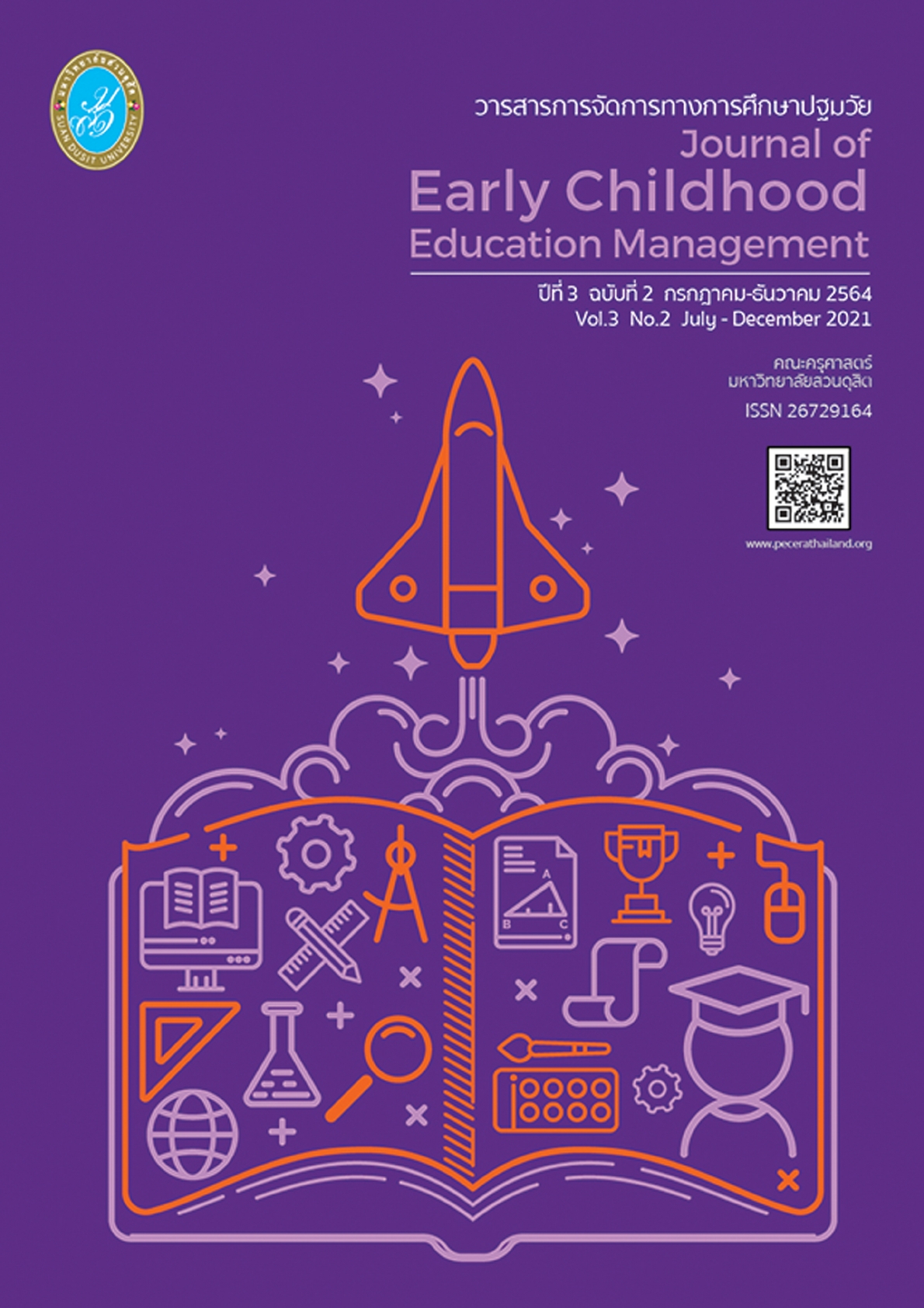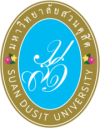การพัฒนาความสามารถภาษาอังกฤษเบื้องต้นสู่ความสำเร็จในการสอบภาษาอังกฤษเพื่อการสื่อสารระหว่างประเทศ TOEIC ของผู้เรียนในระดับอุดมศึกษา
บทคัดย่อ
การทดสอบภาษาอังกฤษเพื่อการสื่อสารระหว่างประเทศ (TOEIC) เป็นการทดสอบการฟังและการอ่านใช้เพื่อประเมินความสามารถทางภาษาอังกฤษของผู้เรียนที่ไม่ใช่เจ้าของภาษาในหลายประเทศเพื่อวัดความสามารถทางภาษาอังกฤษมาตรฐาน ซึ่งมีความแตกต่างจากการใช้ภาษาอังกฤษเพื่อสนทนา
แบบทั่วไป การเขียน หรือหลักสูตรธุรกิจ ในบทความนี้จะเน้นการกล่าวถึงการพัฒนาภาษาอังกฤษเพื่อเตรียมพร้อมกับการประกอบวิชาชีพครูสำหรับการศึกษาระดับระดับสูง (Higher Education) เนื่องจากการเรียนภาษาอังกฤษมีความสำคัญในด้านการศึกษาตลอดมา ทั้งการบรรลุเป้าหมายการเรียนรู้ภาษาอังกฤษโดยทั่วไปเกี่ยวข้องกับการพัฒนาทักษะการสื่อสารทางภาษาทั้งสี่ประการ ได้แก่ การฟังการพูด การอ่าน และการเขียน ซึ่งนำมาสู่การต่อยอดทักษะทางภาษาตามมาตรฐานการพัฒนาภาษาอังกฤษตามกรอบทฤษฎี Common European Framework of Reference for Languages (CEFR) เพื่อเป็นแบบทดสอบมาตรฐานเพื่อการพัฒนาผู้เรียนในทุกระดับ โดยผู้เรียนปริญญาตรีถูกกำหนดให้มีความสามารถภาษาอังกฤษในระดับ B1 Intermediate หรือเทียบเท่า TOEIC 500 คะแนน ด้วยการยกระดับมาตรฐานทางด้านภาษาสำหรับการศึกษาระดับระดับสูง (Higher Education) บทความนี้จึงมีจุดมุ่งหมายเพื่ออภิปรายเนื้อหาเกี่ยวกับการพัฒนาความสามารถภาษาอังกฤษเบื้องต้นสู่ความสำเร็จในการสอบ TOEIC สำหรับประกอบวิชาชีพครูทั้งในระดับประเทศและในระดับนานาชาติ โดยเริ่มจากศึกษาความสำคัญสภาพปัจจุบันและแนวทางในการพัฒนาความสามารถภาษาอังกฤษเบื้องต้นของนักเรียนไทยเพื่อเตรียมความพร้อมในการประกอบวิชาชีพ เนื้อหาของแบบทดสอบ TOEIC และผลของใช้แบบทดสอบ TOEICในสถาบันการศึกษาระดับอุดมศึกษาในต่างประเทศ ปัญหาและแนวทางในการพัฒนาทักษะการฟังและการอ่านเพื่อการสอบภาษาอังกฤษเพื่อการสื่อสารระหว่างประเทศ TOEIC ซึ่งจะเป็นการศึกษาแหล่งข้อมูลของแนวคิดและวิธีการใหม่ ๆ ในการจัดเตรียมบทเรียนที่มีประสิทธิภาพเพื่อเตรียมผู้เรียนภาษาอังกฤษในระดับพื้นฐานให้พร้อมสู่ความสำเร็จในการสอบ TOEIC เพื่อประกอบวิชาชีพในอนาคต
เอกสารอ้างอิง
Blake, H. L., Mcleod, S., Verdon, S., and Fuller, G. (2018). The relationship between spoken English proficiency and participation in higher education, employment and income from two Australian censuses. International journal of speech-language pathology, 20(2), 202-215.
Bachman, L. F. (1990) Fundamental Considerations in Language Testing. Shanghai: Shanghai University Press.
Bozorgian, H. (2012). The relationship between listening and other language skills in International English Language Testing System. Theory and Practice in Language Studies, 2, 657–663.
Celce-Murcia, M. (1991). Grammar pedagogy in second and foreign language teaching. TESOL Quarterly, 25, 459-480.
Chujo, K., and Oghigian, K. (2009). How many words do you need to know to understand TOEIC, TOEFL and EIKEN? An examination of text coverage and high frequency vocabulary. The Journal of Asia TEFL 6(2), 121–148.
Cohen, D. (2006). The Coming of Age of Researchon Test-taking Strategies. Language Assessment Quarterly, 3(4), 112–125.
Darasawang, P. (2007) English Language Teaching and Education in Thailand: A decade of Change, English in Southeast Asia: Varieties, Literacies and Literatures Newcastle D. Prescott (ed.) Cambridge Scholars Publishing October 2007 pp. 187-204.
Duong, T. H. (2016). Difficulties encountered in the TOEIC listening test by the second-year students at University of Economics and Business Administration, Thai Nguyen University. Master’s thesis, Vietnam National University, Hanoi
Frodesen, J., and Holten, C. (2003). Grammar and the ESL writing class. In B. Kroll (Ed.), Exploring the dynamics of second language writing (pp. 141-161).
Goh, C. (1999). Teaching Listening in the Language Classroom. Singapore: SEAMEO Regional Language Centre.
Hamouda, A. (2013). An Investigation of Listening Comprehension Problems Encountered by Saudi Students in the EL Listening Classroom. International Journal of Academic Research in Progressive Education and Development, 2(2), 113-15.
Harley, B., and Swain, M. (1984). The interlanguage of immersion students and its implications for second language teaching. In A. Davies, C., Criper & A. Howatt (Eds.), Interlanguage (pp. 291-311). Edinburgh: Edinburgh University Press.
Hsieh, C.N. (2017) The Case of Taiwan: Perceptions of College Students About the Use of the TOEIC® Tests as a Condition of Graduation https://files.eric.ed.gov/fulltext/EJ1168727.pdf
Krashen, S.D. (1985). The input hypothesis: Issues and implications. Torrance, CA: Laredo Publishing Company Inc.
Kurita, T. (2012). Issues in second language listening comprehension and the pedagogical implications. Accents Asia, 5(1), pp. 30-44.
Liao, C. W., Qu, Y., & Morgan, R. (2010). The relationships of test scores measured by the TOEIC® Listening and Reading Test and TOEIC® Speaking and Writing Tests. TOEIC Compendium, 13.
Lightbown, P., and Spada, N. (1990). Focus on form and corrective feedback in communicative language teaching: Effects on second language learning. Studies in Second Language Acquisition, 12(4), 429-448.
McNamara, T. (2000) Language testing. Oxford: OUP.
Murphy, J. E., Smock, L., Hunter-Adams, J., Xuan, Z., Cochran, J., Paasche-Orlow, M. K., and Geltman, P. L. (2018). Relationships Between English Language Proficiency, Health Literacy, and Health Outcomes in Somali Refugees. Journal of immigrant and minority health, 1-10. Li, Yuan, Bazarova and Bell, 2018
Nhan, T. (2013) The TOEIC® Test as an Exit Requirement in Universities and Colleges in Danang City, Vietnam: Challenges and Impacts. https://www.researchgate.net/publication/327831511_The_TOEICR_Test_as_an_Exit_Requirement_in_Universities_and_Colleges_in_Danang_City_Vietnam_Challenges_and_Impacts
Noom-ura, S. (2013). English-teaching problems in Thailand and Thai teachers' professional development needs. English Language Teaching, 6, 139-147.
Politzer, R. L., & McGroarty, M. (1983). A discrete point test of communicative competence. International Review of Applied Linguistics, 21, 180-190.
Powers, D. E., Yu, F., Yan, F. (2013). The TOEIC® Listening, Reading, Speaking, and Writing tests: Evaluating their unique contribution to assessing English-language proficiency. (TOEIC Compendium Study TC-13-03). Princeton, NJ: Educational Testing Service.
Saaristo, P. (2015). Grammar is the heart of language: Grammar and its role in language learning among Finnish University students. In J. Jalkanen, E. Jokinen, & P. Taalas. Voices of pedagogical development – Expanding, enhancing and exploring higher education language learning. 279-318. Dublin: Research-publishing.net. DOI:10.14705/rpnet.2015000296.
Savignon, S. J. (1972). Communicative competence: An experiment in foreign language teaching. Philadelphia: Center for Curriculum Development.
Scarcella, R., and Oxford, R. (1992). The tapestry of language learning: The individual in the communicative classroom. Boston, MA: Heinle & Heinle.
Sewell, HD. (2005). The TOEIC: Reliability andValidity within the Korean Context. Available: https://www.birminghamdev1.bham.ac.uk/account/accessdenied.aspx?ReturnURL=http%3a
Skehan, P. (1998). A cognitive approach to language learning. Oxford University Press, Oxford.
Stoffelsma, L., and Spooren, W. (2018). The Relationship Between English Reading Proficiency and Academic Achievement of First-Year Science and Mathematics Students in a Multilingual Context. International Journal of Science and Mathematics Education, 1-18.
Swain, M. (1985). Communicative competence: Some roles of comprehensible input and comprehensible output in its development. In S. Gass & C. Madden (Eds.), Input in second language acquisition (pp. 235-253). Rowley, MA: Newbury House.
Thomson, S. (2012) The Effects of TOEIC Education in South Korean Universities https://www.birmingham.ac.uk/documents/collegeartslaw/cels/essays/matefltesldissertations/thomson-tefl--diss.pdf
Tokunaga, M. (2008). Students’ assumptions for TOEIC classes. JALT 2007 Conference Proceedings.Tokyo: JALT, The Educational Testing.
Walters, J. (1980). Grammar, meaning and sociocultural appropriateness in second language acquisition. Canadian Journal of Psychology, 34, 337-345.
Wood, DJ. 2010. Teaching Suprasegmental Featuresof Spoken English through [12] Yod-on, L., Chan-on, P. and Piromyaporn, N. (2012).A Study of TOEIC Listening Test of Students of English for International Communication. Songkhla:Rajamangala University of Technology Srivijaya.
Yagang, F. (1994). Listening: Problems and solutions. In Kral, T., (ed.) Teacher development: Making the right moves. Washington, DC: English Language Programs Division, USIA.
Yiching, P. (2011). Teacher washback from English certification exit requirements in Taiwan. Asian Journal of English Language Teaching, 21, 23–42.
Zahruni, A.A., Fahmi, Pratolo, B.W. (2020) Challenges of Taking TOEIC Test and How to Overcome: Perception of Indonesian Vocational Students. https://www.researchgate.net/publication/343655195_Challenges_of_Taking_TOEIC_Test_and_How_to_Overcome_Perception_of_Indonesian_Vocational_Students
ดาวน์โหลด
เผยแพร่แล้ว
รูปแบบการอ้างอิง
ฉบับ
ประเภทบทความ
สัญญาอนุญาต
ลิขสิทธิ์ (c) 2022 คณะครุศาสตร์ มหาวิทยาลัยสวนดุสิต

อนุญาตภายใต้เงื่อนไข Creative Commons Attribution-NonCommercial-NoDerivatives 4.0 International License.
ลิขสิทธิ์ต้นฉบับที่ได้รับการตีพิมพ์ในวารสารการจัดการทางการศึกษาปฐมวัย ถือเป็นกรรมสิทธิ์ของคณะครุศาสตร์ มหาวิทยาลัยสวนดุสิต ห้ามผู้ใดนำข้อความทั้งหมดหรือบางส่วนไปพิมพ์ซ้ำ เว้นแต่จะได้รับอนุญาตอย่างเป็นลายลักษณ์อักษรจากคณะครุศาสตร์ มหาวิทยาลัยสวนดุสิต นอกจากนี้ เนื้อหาที่ปรากฎในบทความเป็นความรับผิดชอบของผู้เขียน ทั้งนี้ไม่รวมความผิดพลาดอันเกิดจากเทคนิคการพิมพ์




